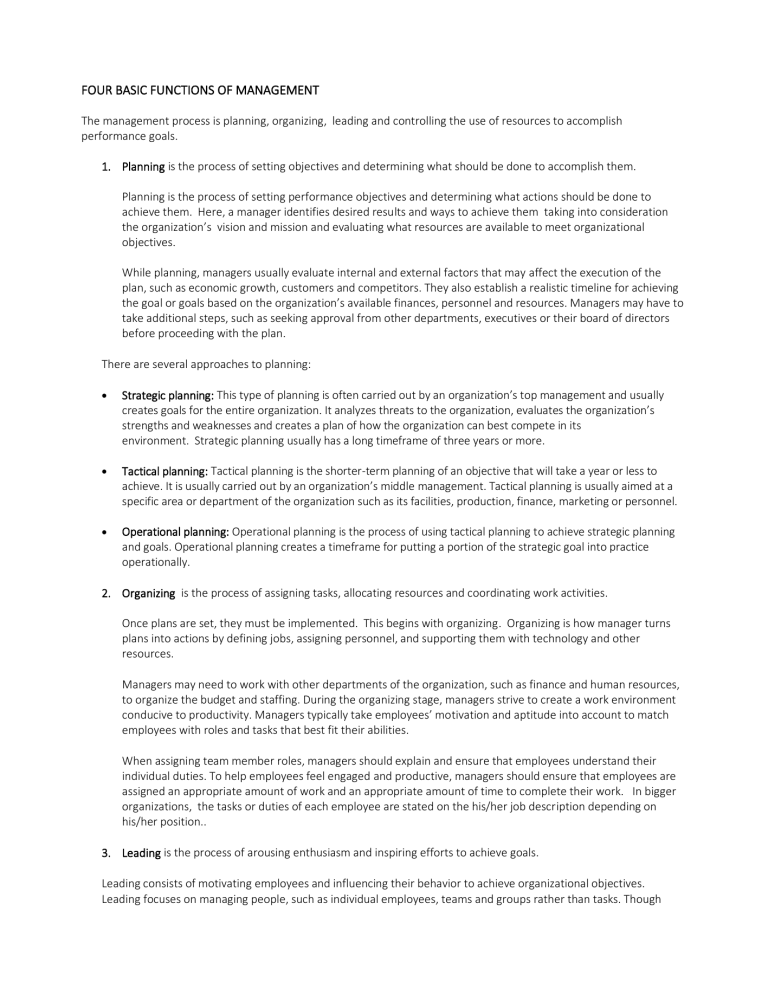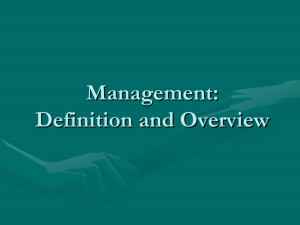
FOUR BASIC FUNCTIONS OF MANAGEMENT The management process is planning, organizing, leading and controlling the use of resources to accomplish performance goals. 1. Planning is the process of setting objectives and determining what should be done to accomplish them. Planning is the process of setting performance objectives and determining what actions should be done to achieve them. Here, a manager identifies desired results and ways to achieve them taking into consideration the organization’s vision and mission and evaluating what resources are available to meet organizational objectives. While planning, managers usually evaluate internal and external factors that may affect the execution of the plan, such as economic growth, customers and competitors. They also establish a realistic timeline for achieving the goal or goals based on the organization’s available finances, personnel and resources. Managers may have to take additional steps, such as seeking approval from other departments, executives or their board of directors before proceeding with the plan. There are several approaches to planning: • Strategic planning: This type of planning is often carried out by an organization’s top management and usually creates goals for the entire organization. It analyzes threats to the organization, evaluates the organization’s strengths and weaknesses and creates a plan of how the organization can best compete in its environment. Strategic planning usually has a long timeframe of three years or more. • Tactical planning: Tactical planning is the shorter-term planning of an objective that will take a year or less to achieve. It is usually carried out by an organization’s middle management. Tactical planning is usually aimed at a specific area or department of the organization such as its facilities, production, finance, marketing or personnel. • Operational planning: Operational planning is the process of using tactical planning to achieve strategic planning and goals. Operational planning creates a timeframe for putting a portion of the strategic goal into practice operationally. 2. Organizing is the process of assigning tasks, allocating resources and coordinating work activities. Once plans are set, they must be implemented. This begins with organizing. Organizing is how manager turns plans into actions by defining jobs, assigning personnel, and supporting them with technology and other resources. Managers may need to work with other departments of the organization, such as finance and human resources, to organize the budget and staffing. During the organizing stage, managers strive to create a work environment conducive to productivity. Managers typically take employees’ motivation and aptitude into account to match employees with roles and tasks that best fit their abilities. When assigning team member roles, managers should explain and ensure that employees understand their individual duties. To help employees feel engaged and productive, managers should ensure that employees are assigned an appropriate amount of work and an appropriate amount of time to complete their work. In bigger organizations, the tasks or duties of each employee are stated on the his/her job description depending on his/her position.. 3. Leading is the process of arousing enthusiasm and inspiring efforts to achieve goals. Leading consists of motivating employees and influencing their behavior to achieve organizational objectives. Leading focuses on managing people, such as individual employees, teams and groups rather than tasks. Though managers may direct team members by giving orders and directions to their team, managers who are successful leaders usually connect with their employees by using interpersonal skills to encourage, inspire and motivate team members to perform at their best. Managers can foster a positive working environment by identifying moments when employees need encouragement or direction and using positive reinforcement to give praise when employees have done their jobs well. Managers usually incorporate different leadership styles and change their management style to adapt to different situations. Examples of situational leadership styles include: • Directing: The manager leads by deciding with little input from the employee. This is an effective leadership style for new employees who need a lot of initial direction and training. • Coaching: The manager is more receptive to input from employees. They may pitch their ideas to employees to work cooperatively and build trust with team members. This style of leadership is effective for individuals who need managerial support to further develop their skills. • Supporting: The manager decides with team members but focuses more on building relationships within the team. This style of leadership is effective for employees who have fully developed skills but are sometimes inconsistent in their performance. • Delegating: The leader provides a minimum of guidance to employees and is more concerned with the vision of the project than day-to-day operations. This style of leadership is effective with employees able to work and perform tasks on their own with little guidance. The leader can focus more on high-level goals than on tasks. 4. Controlling is the process of measuring performance and taking action to ensure desired results. Controlling is the process of measuring work performance, comparing results to objectives and taking corrective action as needed. Through controlling, managers stay active contact with people as they work, gather reports on performance and use this information to make constructive changes. Control is indispensable in the management process. If there are deviations from goals or if goals are not met, plans must often be modified and redefined to best fit new circumstances. During the controlling stage, managers perform tasks such as training employees as necessary and managing deadlines. Managers monitor employees and evaluate the quality of their work. They can conduct performance appraisals and give employees feedback, providing positive remarks on what they are doing well and suggestions for improvement. They may also offer pay raise incentives to high-performing employees. Managers may need to make adjustments such as: Budget adjustments Managers monitor the budget and resources to ensure that they are using the resources available and not going over budget. For example, a manager may notice that she is going over budget on a project but be unsure what is causing the project to go over budget. In this situation, she will need to identify whether there is a general problem with overspending or whether one department, in particular, is going over budget. Once the manager identifies the source of the overspending, she must take action to curb overall spending and make cuts as necessary to balance the budget. Staffing adjustments Managers may need to make challenging decisions such as whether to reassign an employee who produces a lowquality work to a different task or dismiss them from a project. They may also need to add additional team members to meet an organizational goal if they conclude that the team is understaffed. If this is the case, they may also need to consult with organization executives to secure more funding.








